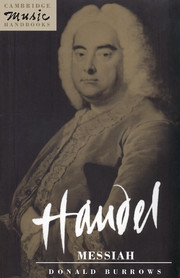Book contents
- Frontmatter
- Contents
- Preface
- References to ‘Messiah’ editions
- 1 The historical background
- 2 From composition to first performance
- 3 The first London performances
- 4 Revival and revision, 1743–1759
- 5 Messiah in other hands
- 6 Design
- 7 Individual movements
- 8 Handel's word-setting
- Appendix 1 The libretto of Messiah
- Appendix 2 Messiah sources
- Notes
- Bibliography
- Index
7 - Individual movements
Published online by Cambridge University Press: 05 June 2012
- Frontmatter
- Contents
- Preface
- References to ‘Messiah’ editions
- 1 The historical background
- 2 From composition to first performance
- 3 The first London performances
- 4 Revival and revision, 1743–1759
- 5 Messiah in other hands
- 6 Design
- 7 Individual movements
- 8 Handel's word-setting
- Appendix 1 The libretto of Messiah
- Appendix 2 Messiah sources
- Notes
- Bibliography
- Index
Summary
Recitatives
The relative insignificance of continuo-accompanied recitatives to Jennens's scheme has already been noted: they are few and short, though they fulil an essential function by introducing new topics that become the subjects of the succeeding arias. Operatic recitatives may sometimes carry considerable emotional weight, at moments of tension or strong feeling that will not bear extension over the longer time-span of an aria. In Messiah, the semplice recitatives are not used in this way, but some important moments are carried by the orchestrally accompanied ones. In Part One, accompanied recitatives are used when the prophet (metaphorically) raises his voice: ‘The voice of him that crieth in the wilderness’ and ‘Thus saith the Lord’; in Part Two they bear the high-point of the Passion tragedy (‘Thy rebuke’, ‘He was cut off’) and introduce the mocking crowd at the Crucifixion (‘All they that see him’). Handel's use of the most conventional type of accompagnato texture – a sustained wash of string chords – is the more effective by being limited to the Passion recitatives in Part Two and ‘Behold, I tell you a mystery’ in Part Three. Prophetic moments call forth emphatic rhythmic figures to punctuate the vocal phrases (‘The voice of him’, ‘Thus saith the Lord’), and the same technique proves effective for ‘All they that see him’ and the revised ending to ‘Why do the nations?’
- Type
- Chapter
- Information
- Handel: Messiah , pp. 68 - 74Publisher: Cambridge University PressPrint publication year: 1991

